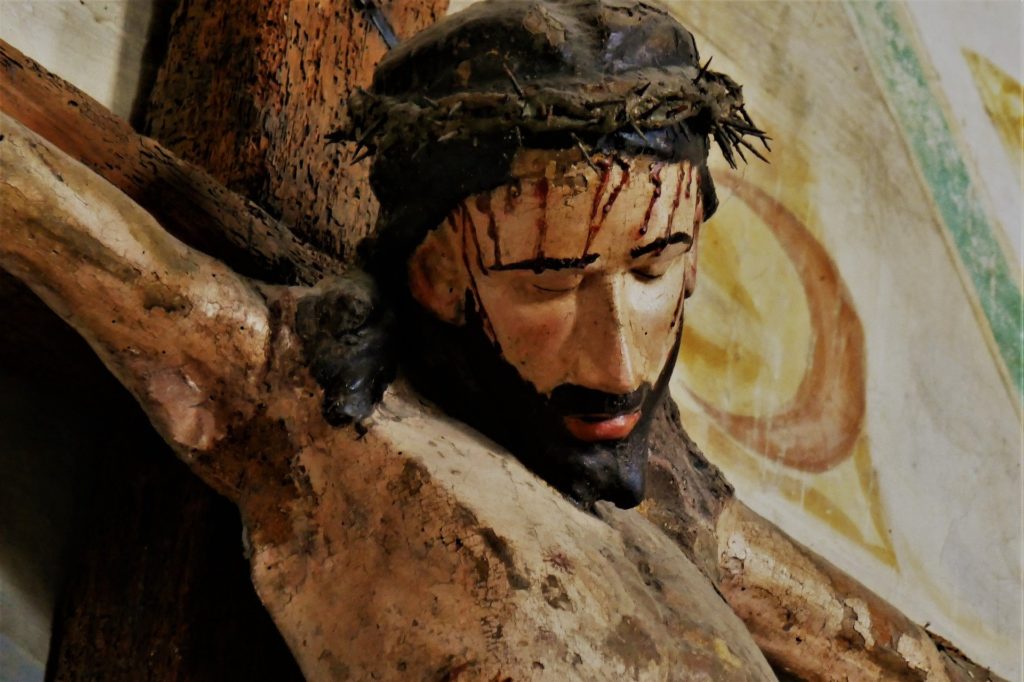
Good Friday of the Lord’s Passion (also called “Good Friday” for short) is traditionally where Catholics worldwide remember the passion, suffering and death of Jesus Christ. It is the second in the three days of Easter Triduum (see Easter Triduum info here). Central to the feast day is the teaching by the Church that the death of Jesus Christ on the Cross happened so that God can forgive all of the sins of all mankind throughout all time including the error of original sin dating back to the first people (Adam and Eve). At the time Jesus was crucified the feast of Passover was being prepared for by the faithful Jewish people. So it is understood while Christ died, at the same time the Passover lamb was being killed and prepared for consumption by those same Jewish people of Jesus’ time. In this way, Jesus Christ becomes the Passover lamb who takes on the sins of the world though He Himself was without sin or fault. This makes His selfless sacrifice perfect for all time requiring no further a bloody sacrifice to be made by God’s people (now all people because of this act– not just the Jews any longer) and in turn shows Jesus’ worthiness as Messiah, Savior, and King as being truthful forever. Jesus, hidden by the veil of humiliating execution on the cross as perceived by the authorities of His time, was really conquering death, sin, and the Devil’s hold on mankind at a spiritual level. This would be revealed come His resurrection on Easter Day and His sending forth of the Holy Spirit to all God’s people on Pentecost. Today though is a sober memorial where Christians deal with the mourning of His death and just how incredible Jesus Christ’s love for us is in His willingness to die for our sins.
On this day the Church does not celebrate Mass. The main altar in the church remains completely bare and the Tabernacle is empty. All consecrated Communion wafers are moved to a secondary Tabernacle away from the Sanctuary of the altar (usually in a smaller public chapel or private area of the Church). It is at the 3 o’clock hour on Good Friday that Jesus dies on the Cross according to the Gospel and tradition. At this hour His Divine Mercy is still being poured out onto the whole world. At this same hour the Christian faithful therefore should observe a solemn and prayerful silence in memory of the hour in which our salvation was won at so great a price.
With Catholic churches throughout the United States closed for public prayer and some open for only private prayer because of the ongoing COVID-19 epidemic, here are some ways you can spend today in prayer and close to Jesus Christ despite the challenges present in our current “shelter in place” situation.
STATIONS OF THE CROSS
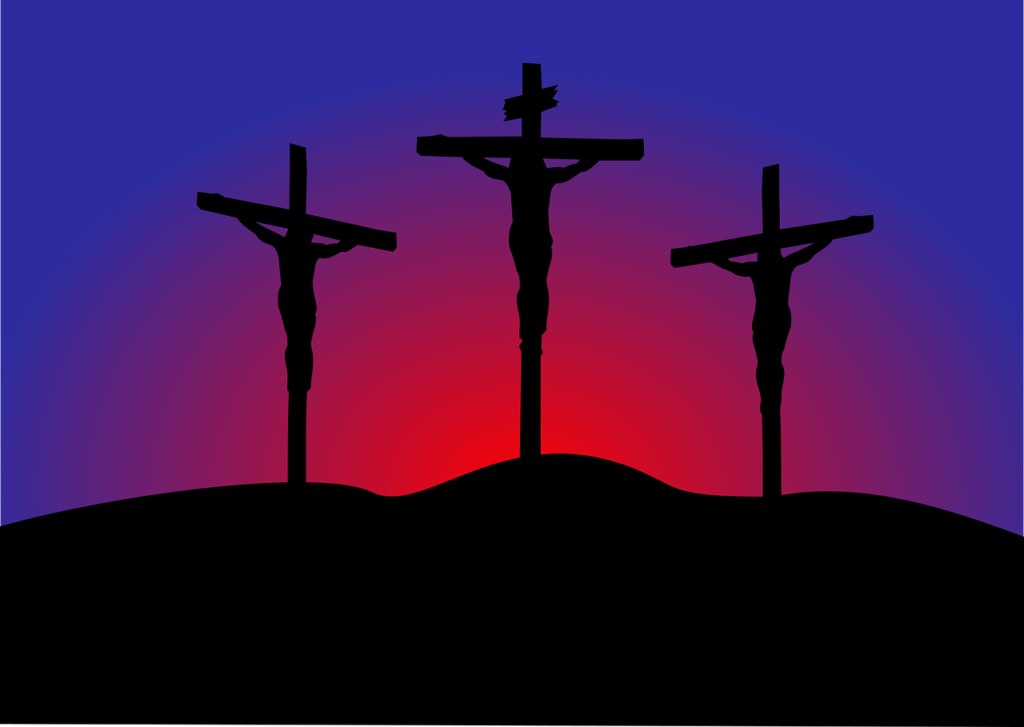
Throughout Lent, every Friday including Good Friday we pray the Stations of the Cross. This traditional devotion dates back to when Christian pilgrims would make their way to Jerusalem and retrace Jesus Christ’s last hours throughout the city as a sign of devotion. Today, the Stations are said in Churches throughout the world. Most churches have the stations setup throughout the church and usually along the outside walls of the main pews where parishioners sit for mass and other celebrations. Stations of the Cross can be as simple as wooden pictures, large multidimensional sculpted paintings, or even ornate prayer stations to kneel at to pray before. There are fourteen Stations of the Cross. Each recounts key moments in the Passion of Jesus Christ. Each station is prayed upon with a fixed set of prayers by the faithful (either by yourself or in a group service where an altar server stands before the station being venerated). At each station the moment that station memorializes is recounted by the priest or Deacon leading the group devotional prayer service. More on this devotion can be found here. Stations normally take place on Good Friday in the afternoon before the Good Friday service. Good Friday service is normally offered at 3 pm as this is the hour that the Church recognizes as the hour of Jesus’ expiration and therefore also is the hour of His Divine Mercy. Therefore any time during noon and 3 pm would be appropriate for you to say the Stations of the Cross at home on Good Friday. Traditionally on other Fridays of Lent Stations are said between 5 and 7 pm (usually before dinner).
You do not need to purchase a full Stations of the Cross picture set (though they do exist) to practice this devotion. There are many applications that work on both Apple and Android mobile phones and devices that virtually recreate the Stations of the Cross for you on your mobile device. The Laudate app is one such program that does this. It can be found for Apple devices here and for Android devices here. Once installed on your device, open the app and you will see on the Main Laudate page a “Stations of the Cross” section. Tap on that section. You will then be able to work your way through all fourteen stations. Start with the “Opening Prayer” and then go back to the Stations page. You then make your way through each station go back and forth as needed to continue moving through each station. At the end of the stations you can recite any number of prayers that you wish to conclude your mediation on Jesus Christ’s Passion, Death, and Resurrection with. If you go back to the Main Laudate app page (where you found the Stations of the Cross section once you opened the app) you will find another a section called “Prayers” where you can spend time reciting any number (large or small in amount) of prayers that are available in the app. Make sure you make some time after praying to reflect silently on what Jesus Christ was willing to do for you, how He continues to do this work today through the Church and its people, and how great his Divine Mercy love is for you and all the people of the world.
GOOD FRIDAY SERVICE – THE LORD’S PASSION
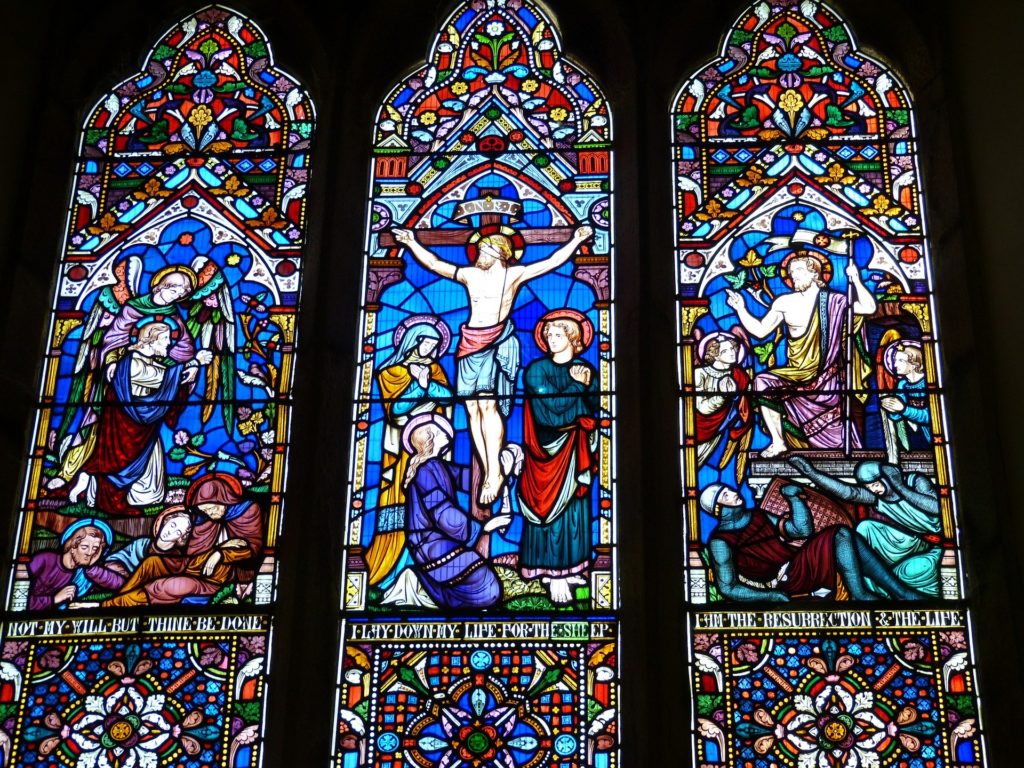
The Good Friday service is called “The Lord’s Passion” and recounts Jesus Christ’s Passion. The Passion is the memorial retelling of how Jesus was arrested, put before religious and civic leaders for questioning, unfairly accused and tried by the religious and civic leaders of His time, tortured and humiliated by civil authorities, sentenced to death by a public crowd tricked into doing so by the same religious leaders who accused Him wrongly, paraded through the street where He is humiliated and further tortured, and ultimately crucified at the execution site called Golgotha just outside the city of Jerusalem. During His suffering on the cross a thief who has also been crucified beside Jesus mocks Him and another one defends Him. Jesus forgives the “good thief” at this time. Christ dies nearly alone with only a few brave disciples and his own mother, the Blessed Virgin Mary, present after three hours of suffering (between noon and 3 pm). Peter, who has been named Jesus’ successor by Jesus Himself just days before, denies knowing Christ three times to those in the crowd while Jesus is being tried. Peter runs away believing himself a failure unworthy of being the “Rock” Christ plans to build His earthly Church upon. Judas Iscariot, who betrayed Christ for a few silver pieces, commits suicide under his own guilt after he witnesses Jesus die with such loving humility for even those who hate Him. Jesus breaths one last breathe and dies after having said only seven words while on the cross. His side is pierced with a lance by a solider trying to figure out if He is really dead or not. The world literally shakes and then all falls silent. Christ is dead and left to be buried by the few who stayed behind to be with Him in His final hours. Once Jesus dies He is then taken down and buried at the request of one of his brave disciples who asks for His body. Finally he is entombed in a cave burial after being wrapped in burial linens by his few remaining disciples as many of His other disciples along with the Apostles (minus John who stays and is entrusted with by Jesus just before he dies with caring for His blessed Mother Mary) have fled into hiding. The story stops here for Good Friday. All looks bleak, but the veil hides the truth.
Ultimately, after three days, the tomb will be rolled open by an angel and revealed to be empty on the following Sunday morning. The veil opens a bit more. Is Jesus Christ still alive? (spoiler alert– the answer is yes) The story stops here at Easter Sunday mass, but it is far from over. Many disciples and ultimately the Apostles will encounter the risen Christ then spend another month with Him. Peter would be forgiven by Jesus for his earlier denial and entrusted as His successor to lead the Church on Earth. The Apostles would come from hiding and be taught by Jesus including Christ “opening their minds” to all He knows. His divine revelation is now entrusted to them. Hundreds would see Him and attest to Him living during this time. Christ would eventually rise to Heaven before a large group of disciples and the Apostles ending His physical time on Earth. Forty days later the Holy Spirit would come on Pentecost and renew the faith of his Apostles who would then begin the mission to found the Catholic Church, preach to the Gentiles, and begin what we know as Christianity. From that point on Christ would be spiritually present in the Blessed Sacrament of the Eucharist, as well as, in the Holy Spirit. Two thousand years later that mission and this celebration continues despite wars, famines, epidemics, and persecution.
On Good Friday, no Eucharist is consecrated by the celebrant priest. Instead left over Eucharist from the prior Holy Thursday mass is used in a service. A service is where prayers are said and Liturgy of the Word (Bible scripture) is read, but no Eucharist is consecrated by the celebrant priest. Mass requires that a Eucharist be consecrated and only a priest can do this. A service though can be said by a priest or Deacon as such since there is no consecration celebrated. In this particular service’s case though, the service Liturgy and celebration is always lead by a priest. The church has been stripped bare and all holy objects of adornment are covered to “hide” Christ. This is done at the end of Holy Thursday Eucharist adornment. This makes the church very bare and empty feeling during the mass. Again this is to reinforce that Christ is to suffer, die and be hidden for three days from His faithful.
Our own parish, the Church of the Infant Saviour (Pine Bush, NY) will be streaming its Good Friday service this afternoon (4/10/20) at 3 pm EST via the Parish Facebook page found here. Once finished as a live stream, the service will then be available via replay from that same page at any time. So if you do miss it, feel free to watch it later and spend a hour adoring the Lord and thanking Him for willing taking upon Himself all our sins.
Other options for mass include:
Our Lady of Mount Carmel, Middletown, NY – Found here.
Whitefriars Hall, Washington, DC – Found here.
Many parishes throughout the Archdiocese of New York are live-streaming Masses each day. You can find links to them here.
All of the Holy Week liturgies will also be celebrated in St. Patrick’s Cathedral and are available via live-stream here.
For Good Friday service, these services above will be live streamed at 3 pm (local time) today and then will be posted for replay once the mass concludes. Consult each web site link for times and more information on this.
VENERATION OF THE CROSS
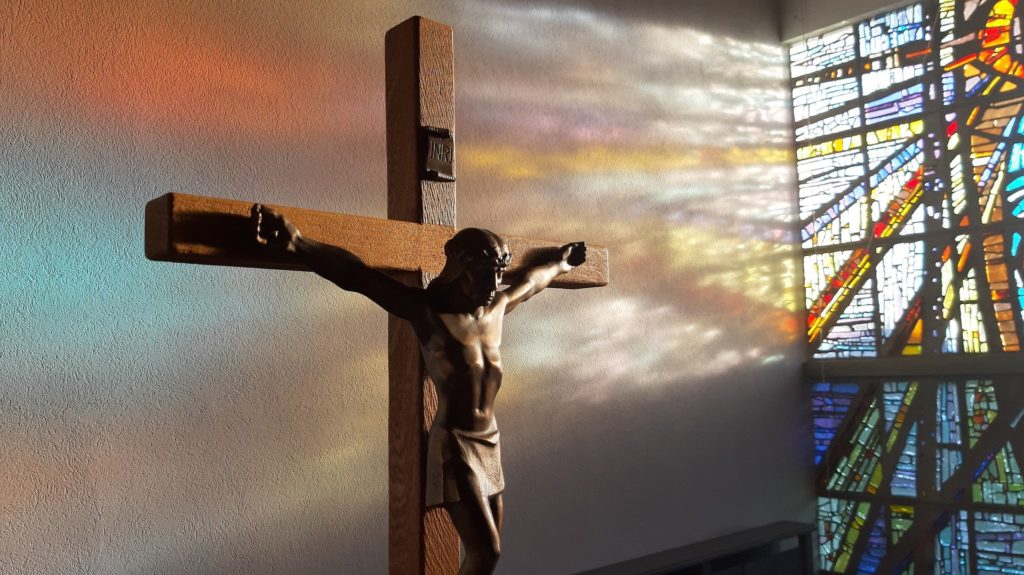
The Good Friday mass service with the adornment of the crucifix. A practice where parishioners kiss the feet of Jesus Christ on the cross to show their love for Him and to thank him for being the Savior who suffered for all the sins of the world in order that they would be forgiven through his selfless perfect sacrifice. The tradition of the Veneration of the Cross dates back to the fourth-century. On Good Friday, the Christians in Jerusalem would gather before a relic of the true cross to kneel, bow, and kiss the cross in remembrance of the Passion of Christ.
Before being venerated by the faithful in this manner, on Good Friday today the crucifix is paraded through the church usually by the Deacon (though a priest may do this as well) where with each few steps forward it is slowly uncovered from underneath a cloth sheet. This slow revealing of the crucifix recounts how on Easter Triduum it would be slowly, but surely revealed to the Apostles and disciples of Jesus Christ that He had risen from the dead in a new glorified body as the Messiah. The veil is lifted and the disciples of Christ can finally see the cross for what it truly is– the sign of our salvation!
You can venerate a cross at home after watching online mass. There are three steps to home cross veneration:
First place a cross in a place that makes it convenient for veneration. Like on a table with some lit candles. A standing cross is preferred so you can see it when kneeling down, but it does not have to be. You can just lay it on the table. Alternately you can use a cross hanging on a wall in your home. Again in an area where you can kneel down below it.
Next, kneel before the crucifix and spend some time in prayer. Begin your prayers with the Sign of the Cross. If you want you can use the Laudate app discussed above and the prayers in it or you can just recite those you know.
Still kneeling thank Jesus for the gift of our salvation, make an act of contrition (again this prayer can be found in the Laudate app Prayer section or online here as part of our “Confession 101 Refresher” article) and say the prayer below:
Behold, O kind and most sweet Jesus, I cast myself upon my knees in Thy sight, and with the most fervent desire of my soul, I pray and beseech Thee that Thou wouldst impress upon my heart lively sentiments of faith, hope and charity, with true contrition for my sins and a firm purpose of amendment; while with deep affection and grief of soul I ponder within myself and mentally contemplate Thy five wounds, having before my eyes the words which David, Thy prophet put on Thy lips concerning Thee: ‘They have pierced My hands and My feet, they have numbered all My bones’ (Psalm 21: 17,18).
Say an Our Father, Hail Mary, and Glory Be. Spend as much time in prayer as you would like whether it just be silent mediation or vocal.
Finally, when you feel ready, stand up and kiss the crucifix where Jesus’ feet is. Remember how much He loves you while you do. Make the Sign of the Cross to close your veneration.
DIVINE MERCY
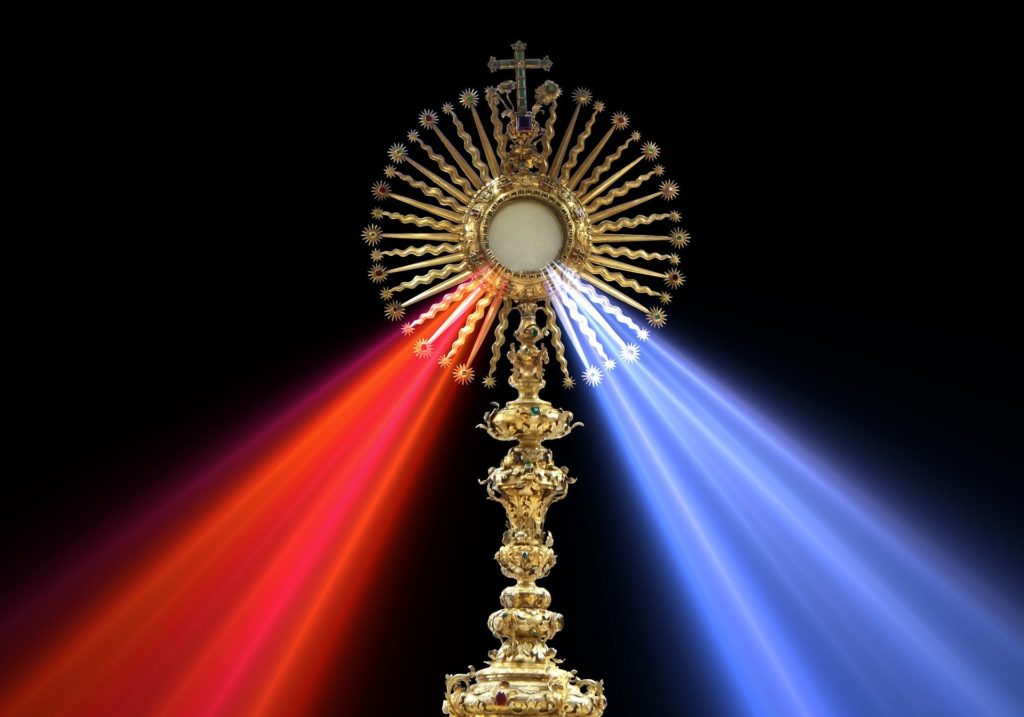
As discussed earlier in this article, Jesus Christ poured out his Divine Mercy on us with his sacrifice on the cross once bloody and forever unbloody in the Paschal mystery of the Blessed Sacrament of the Holy Eucharist. After you finish Veneration of the Cross or perhaps just before you finish pray the Divine Mercy. You can read about this devotion in our article entitled “The Devotion of Divine Mercy” that can be found here.
The Knights of Columbus and their families are encouraged to join in praying the Divine Mercy Novena beginning today, Good Friday.
During the 1930s, Jesus revealed the depths of His merciful love for mankind to a Polish nun, St. Faustina Kowalska. After her death in 1938 at age 33, Sister Faustina’s diary became a manual for the Divine Mercy devotion, and from it came a nine-day series of prayers intended to be offered starting on Good Friday, in preparation for the Feast of Divine Mercy (the Second Sunday of Easter).
This novena was given by Jesus particularly to St. Faustina Kowalska (Diary, 1210-1229). For each of the nine days, our Lord gave her a different intention — a different group of souls — which He wanted her to bring to Him in prayer. The Lord Jesus promised: “By this novena, I will grant every possible grace to souls” (Diary, 796).
Pope John Paul II, who in 2000 canonized St. Faustina and established the Divine Mercy Sunday for the universal Church, said, “Those who sincerely say ‘Jesus, I trust in You’ will find comfort in all their anxieties and fears” (Krakow, Poland, June 7, 1997).
Join brother Knights and the faithful worldwide in praying this novena and invoking God’s mercy in this time of global pandemic. Download the full Novena, as well as, prayers here and join the Sisters of Our Lady of Mercy, St. Faustina’s religious order, online to pray the novena at 3 p.m. EDT daily on YouTube and Facebook from the Saint John Paul II National Shrine in Washington, D.C. The live daily broadcasts will also available on demand after the initial broadcast at 3 p.m.
Finally, please mark your family calendars for April 19, starting at 3 p.m., to tune in and participate in a special Divine Mercy Sunday Mass offered by Supreme Chaplain Archbishop William Lori at the Baltimore Basilica, where Father Michael McGivney was ordained a priest. The broadcast will also include the praying of the Divine Mercy chaplet following Mass.
CONCLUSION
This year Good Friday falls on April 10, 2020. It is a year where the Jewish feast of Passover coincidences with the Christian feast of Good Friday. This is especially meaningful for Christians as it is because He wishes to celebrate the Passover Seder meal that Jesus Christ holds the Last Supper (celebrating on the preceding day of Holy Thursday as discussed here) in preparation for His Passion and ultimately with His Resurrection on Easter Sunday. The Passover Meal this year (celebrated at sundown on Wednesday; April 8, 2020) is a primordial archetype that ultimately is fulfilled in the Last Supper where the Lord institutes the Priesthood and the Sacrament of the Holy Eucharist. Passover ends on Thursday and it is at that end on the early hours of Friday that Jesus Christ is confronted in the garden by Jewish authorities and his betrayer Judas Iscariot. Also it is on Friday that traditionally Christ is believed to have been crucified according to the Gospels. Jesus dies before the end of the day when sundown happens at 3 pm according to the Gospels. This is key because it means he dies before the Jewish Sabbath is to begin and therefore the Romans do not break his legs to expedite his death before sundown as was a custom (no one was supposed to die on the Sabbath so they make sure to speed things up hours before it happens as brutal as that sounds). This is all part of prophecy. This year though isolated and maybe more so because of that isolation we can experience Good Friday in a new way that is both authentic and maybe a bit all too real as we face our own Passover moment during this epidemic. Much like the Jews of Moses’ time, the Jews in Babylonian exile of the Jewish Prophets’ time, the first Jewish Christian disciples and Apostles of Christ’s time, and many Christians who have been persecuted up until our very own time today– we find ourselves huddled together in prayer. It is especially during these trying times as it is with all trying times before that we need the Lord more than ever in our lives. It is the hope of our Council that these resources can help you and those who you hold dear do that this Easter Triduum. Vivat Jesus!

You must be logged in to post a comment.